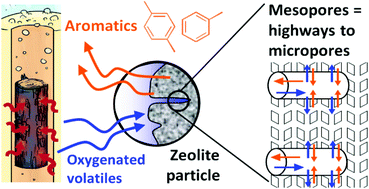当前位置:
X-MOL 学术
›
Green Chem.
›
论文详情
Our official English website, www.x-mol.net, welcomes your
feedback! (Note: you will need to create a separate account there.)
Catalytic fast pyrolysis of biomass: superior selectivity of hierarchical zeolites to aromatics
Green Chemistry ( IF 9.3 ) Pub Date : 2017-09-04 00:00:00 , DOI: 10.1039/c7gc02309j L. Y. Jia 1, 2, 3, 4, 5 , M. Raad 6, 7, 8, 9, 10 , S. Hamieh 10, 11, 12, 13, 14 , J. Toufaily 10, 11, 12, 13, 14 , T. Hamieh 10, 11, 12, 13, 14 , M. M. Bettahar 1, 2, 3, 4, 5 , G. Mauviel 1, 2, 3, 4, 5 , M. Tarrighi 6, 7, 8, 9 , L. Pinard 6, 7, 8, 9 , A. Dufour 1, 2, 3, 4, 5
Green Chemistry ( IF 9.3 ) Pub Date : 2017-09-04 00:00:00 , DOI: 10.1039/c7gc02309j L. Y. Jia 1, 2, 3, 4, 5 , M. Raad 6, 7, 8, 9, 10 , S. Hamieh 10, 11, 12, 13, 14 , J. Toufaily 10, 11, 12, 13, 14 , T. Hamieh 10, 11, 12, 13, 14 , M. M. Bettahar 1, 2, 3, 4, 5 , G. Mauviel 1, 2, 3, 4, 5 , M. Tarrighi 6, 7, 8, 9 , L. Pinard 6, 7, 8, 9 , A. Dufour 1, 2, 3, 4, 5
Affiliation

|
The catalytic fast pyrolysis of oak over two zeolites (microporous and hierarchical) was investigated in a microfluidized bed reactor (MFBR) at 500 °C and as a function of the biomass-to-catalyst ratio. A hierarchical zeolite was produced by desilication with a NaOH solution of a conventional HZSM-5 zeolite. The outlet of the MFBR was connected to a single photoionization mass spectrometer (SPI-MS) for the on-line analysis of volatiles. This on-line analysis method allows studying the dynamics of volatile formation (in real time) and the deactivation of 2 zeolites upon stepwise injections of wood particles. Strikingly, the selectivity of targeted mono-aromatic compounds (quantified by gas chromatography) is doubled after desilication of the zeolite. The coked zeolites were characterized by TEM-EDX, digestion in fluoric acid, MALDI-TOF MS, etc. Three different types of coke are evidenced: (1) coke trapped inside micropores, (2) external coke formed on the outer surface of the crystals and (3) coke precursors deposited in the mesopores. The latter two cokes are much less toxic than the microporous coke. The open mesopores produced after desilication can be seen as “highways” where big molecules (such as levoglucosan) can diffuse to more accessible pore mouths. Brønsted acid sites present on microporous mouths can be active for the conversion of bigger molecules to small fragments. These fragments diffuse and form aromatics in the micropores (shape selectivity). The mesopores also promote the evacuation of catalytic products, thus enhancing the selectivity of mono-aromatic hydrocarbons. Desilicated zeolites present higher selectivity to mono-aromatics and stability upon coke deposition than microporous zeolites.
中文翻译:

生物质的催化快速热解:分级沸石对芳烃的优异选择性
在500°C的微流化床反应器(MFBR)中,根据生物质与催化剂的比例,研究了橡木在两种沸石(微孔和分级)上的催化快速热解。通过用常规HZSM-5沸石的NaOH溶液进行脱硅来生产分层沸石。MFBR的出口连接到单个光电离质谱仪(SPI-MS),用于在线分析挥发物。这种在线分析方法允许(逐步)研究挥发物形成的动力学以及逐步注入木屑后2种沸石的失活。令人吃惊的是,沸石脱硅后,目标单芳族化合物(通过气相色谱法定量)的选择性增加了一倍。焦化的沸石的特征在于TEM-EDX,在氟酸中消解,MALDI-TOF MS,ETC。证明了三种不同类型的焦炭:(1)被困在微孔内部的焦炭;(2)在晶体外表面上形成的外部焦炭;(3)沉积在中孔中的焦炭前体。后两种焦炭的毒性远低于微孔焦炭。脱硅后产生的开放中孔可以看作是“高速公路”,大分子(如左旋葡聚糖)可以扩散到更易接近的口中。存在于微孔口上的布朗斯台德酸位点对于将大分子转化为小片段可能是活跃的。这些碎片在微孔中扩散并形成芳香族化合物(形状选择性)。中孔还促进了催化产物的排出,从而提高了单芳族烃的选择性。
更新日期:2017-11-13
中文翻译:

生物质的催化快速热解:分级沸石对芳烃的优异选择性
在500°C的微流化床反应器(MFBR)中,根据生物质与催化剂的比例,研究了橡木在两种沸石(微孔和分级)上的催化快速热解。通过用常规HZSM-5沸石的NaOH溶液进行脱硅来生产分层沸石。MFBR的出口连接到单个光电离质谱仪(SPI-MS),用于在线分析挥发物。这种在线分析方法允许(逐步)研究挥发物形成的动力学以及逐步注入木屑后2种沸石的失活。令人吃惊的是,沸石脱硅后,目标单芳族化合物(通过气相色谱法定量)的选择性增加了一倍。焦化的沸石的特征在于TEM-EDX,在氟酸中消解,MALDI-TOF MS,ETC。证明了三种不同类型的焦炭:(1)被困在微孔内部的焦炭;(2)在晶体外表面上形成的外部焦炭;(3)沉积在中孔中的焦炭前体。后两种焦炭的毒性远低于微孔焦炭。脱硅后产生的开放中孔可以看作是“高速公路”,大分子(如左旋葡聚糖)可以扩散到更易接近的口中。存在于微孔口上的布朗斯台德酸位点对于将大分子转化为小片段可能是活跃的。这些碎片在微孔中扩散并形成芳香族化合物(形状选择性)。中孔还促进了催化产物的排出,从而提高了单芳族烃的选择性。











































 京公网安备 11010802027423号
京公网安备 11010802027423号